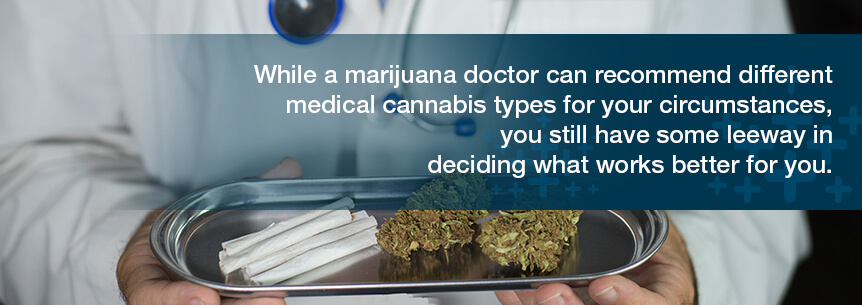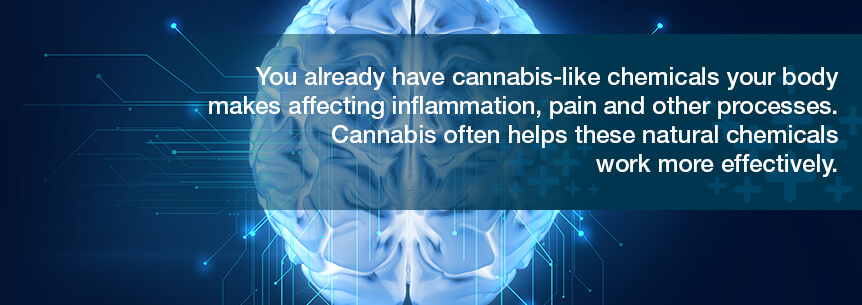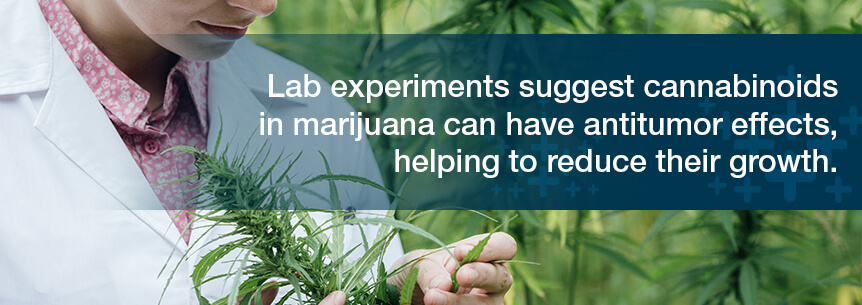To many in the U.S. and all over the world, medical marijuana represents an opportunity to alleviate their debilitating symptoms. They see it as an essential therapeutic solution, and they couldn’t treat their health conditions without it.
In U.S. states where cannabis is legal, physicians recommend it medically for various qualifying diseases and conditions, most of which are chronic. So how does medical marijuana work to treat these conditions?
The amazing healing properties of marijuana come from its significant levels of medical flavonoids and terpenes as well as its high levels of CBD. While its psychoactive compound THC is what recreational users are after, it’s the CBD in medical marijuana that makes it therapeutic and beneficial to those suffering from chronic illnesses. Growers are starting to produce higher CBD-level and lower THC-level cannabis plants for medical use through seed exchanges and plant breeding techniques.
Before you start medical cannabis therapy, it helps to learn more information about it and how your brain functions so you know why the herb affects you the way it does. While a marijuana doctor can recommend different medical cannabis types for your circumstances, you still have some leeway in deciding what works better for you.

Therefore, having a better understanding of medical weed and its chemicals you’ll be dealing with will help make the herb less intimidating when it comes time to use this treatment.
Medical cannabis breeders can separate the different effects of the plant. The following are some of marijuana’s compounds and their effects:
Breeders are continuously adjusting their hybrid blends to balance out different compounds in each marijuana type. These adjustments help breeders to create medical cannabis that targets specific symptoms and types of therapy.
Your brain is a complicated organ. It manages your thoughts, emotions and bodily functions, and it works through a chemical-based communication system. Your brain and other areas of your nervous system produce chemicals known as neurotransmitters. These neurotransmitters deliver messages to different structures referred to as receptors.
Researchers have found the following cannabinoid receptors in your body.
1. CB1 receptor
The CB1 receptor is mostly present in your:
2. CB2 receptor
The CB2 receptor is what your immune system cells express. Your bodily tissues have these two receptors with different associated actions.
Your receptors read and react to the messages. They sometimes send chemical messages out to alter different physical functions — like moving your hand from a hot burner or slowing down your heart rate. Others generate brain chemicals inducing emotions to increase sensations of euphoria or stress. This all occurs in your brain.

You already have cannabis-like chemicals your body makes affecting inflammation, pain and other processes. Cannabis often helps these natural chemicals work more effectively.
Your brain areas containing most of the cannabinoid receptors are the:
They widely exist in the areas of your brain related to your memory, motivation, reward and drive. Therefore, when you use weed, your motivation and reward areas light up, which delivers a sense of euphoria as your brain continues to release more reward neurotransmitters. However, you also lose your ability to form new memories due to the herb impairing your short-term memory and ability to differentiate between what is and isn’t important. This will likely make you feel relaxed and easily distracted.
Additionally, since cannabis affects your hippocampus, it also affects your appetite. That’s why many people get what’s known as “the munchies.”
You can break your brain down into numerous neurotransmitter types and their equivalent receptors. Although a basic message could indicate a certain neurotransmitter being sent out and the appropriate receptor receiving it, most messages are the result of a combination of unique neurotransmitters going through your brain. These neurotransmitters work in groups. For instance, you have a few different “feel-good” chemicals: dopamine, serotonin and adrenaline. The balance between these chemicals in various brain areas determines your shades of emotion.
Your neurotransmitters in your brain make it so you can do everything from wiggle your finger to remembering your first crush. Researchers have begun mapping out the receptors and neurotransmitters involved in specific functions of your brain. That information is then used to create different medicines to help improve your life quality.
Patients turn to medical cannabis for many different reasons, one of which is the treatment of chronic pain. Marijuana can relieve stubborn pain, or at least reduce it enough to make it tolerable.
Studies most encouraging are those evaluating medical cannabis use in cancer patients with chronic pain. That pain is due to various things such as:
Cancer pain tends to be persistent, severe and resistant to opiate painkiller treatment. Because of this, researchers are trying to find other pain medications besides opiates.
In a study with 10 participants who had advanced stages of cancer, researchers gave them four different doses of THC pills and a placebo. All patients received a whole range of similarly-looking pills over the length of the study period. When patients were given 15 and 20-milligram doses of THC, the highest doses, they reported substantial relief of their pain compared to the days they were given 0 through 10 milligrams.
Every person has receptors and an endocannabinoid system in their body. Their cannabinoid system in each tissue performs a different role, but the main objective is to maintain a stable internal environment regardless of external environment fluctuations. Cannabis compounds mimic your body’s natural chemicals.
CBD and THC have displayed various pharmacologic activities giving them their ability as therapeutic agents. THC works as an antagonist to decrease pain when breeders combine it with CBD.
Brain imaging displays little decrease in the regions of the brain coded for pain sensation, as you’d normally see with opiate-type drugs. Instead, marijuana seems to affect the emotional reaction to pain mostly. Because weed doesn’t affect your brain’s pain centers, it doesn’t have addictive traits to it like opiates and, therefore, patients are less likely to become addicted to it.

Lab experiments also suggest cannabinoids in marijuana can have antitumor effects, helping to reduce their growth.
Other reasons people turn to medical cannabis includes benefitting from CBD’s therapeutic properties, such as:
Cannabinoids engage with your system through your natural, cell membrane-embedded receptors throughout your body. You have these receptors in your lungs, brain, immune system, kidneys and liver.
Both psychoactive and therapeutic properties of cannabis occur when a cannabinoid activates one of your cannabinoid receptors.
Although research is still ongoing in terms how marijuana affects your health, as of today, researchers know cannabinoid receptors play a considerable role in the processes of your body including:
And, different patients’ experiences vary. While one may feel the release of stress, another will feel stressed or over-stimulated. Someone else may feel on-task and energized. Various factors, such as those below, affect these experiences, too:
With these personal variables and the different plant variations, there are plenty of opportunities to consume medical cannabis in a manner offering you the most benefit for your health ailment.
If you try medical cannabis treatment and you don’t experience results, or you experience some side effects you don’t like, simply try another variation until you find success. As you’ll learn in the next chapter, you can work with different strains to achieve your desired results.